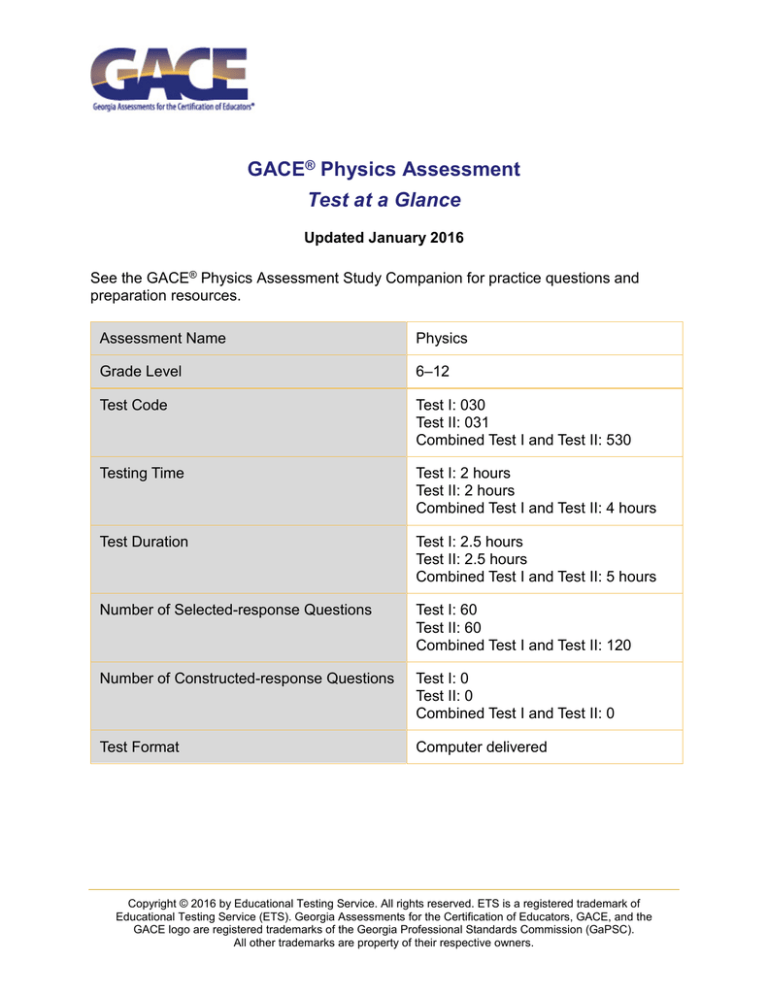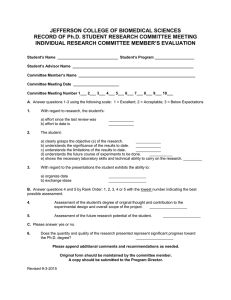
GACE® Physics Assessment
Test at a Glance
Updated January 2016
See the GACE® Physics Assessment Study Companion for practice questions and
preparation resources.
Assessment Name
Physics
Grade Level
6–12
Test Code
Test I: 030
Test II: 031
Combined Test I and Test II: 530
Testing Time
Test I: 2 hours
Test II: 2 hours
Combined Test I and Test II: 4 hours
Test Duration
Test I: 2.5 hours
Test II: 2.5 hours
Combined Test I and Test II: 5 hours
Number of Selected-response Questions
Test I: 60
Test II: 60
Combined Test I and Test II: 120
Number of Constructed-response Questions
Test I: 0
Test II: 0
Combined Test I and Test II: 0
Test Format
Computer delivered
Copyright © 2016 by Educational Testing Service. All rights reserved. ETS is a registered trademark of
Educational Testing Service (ETS). Georgia Assessments for the Certification of Educators, GACE, and the
GACE logo are registered trademarks of the Georgia Professional Standards Commission (GaPSC).
All other trademarks are property of their respective owners.
About this Assessment
The GACE Physics assessment is designed to measure the professional knowledge of
prospective teachers of secondary school Physics in the state of Georgia.
This assessment includes two tests. You may take either test individually or the full
assessment in a single session. The testing time is the amount of time you will have to
answer the questions on the test. Test duration includes time for tutorials and directional
screens that may be included in the test.
The questions in this assessment assess both basic knowledge across content areas
and the ability to apply principles.
The total number of questions that are scored is typically smaller than the total number
of questions on the test. Most tests that contain selected-response questions also
include embedded pretest questions, which are not used in calculating your score. By
including pretest questions in the assessment, ETS is able to analyze actual test-taker
performance on proposed new questions and determine whether they should be
included in future versions of the test.
Content Specifications
Each test in this assessment is organized into content subareas. Each subarea is
further defined by a set of objectives and their knowledge statements.
The objectives broadly define what an entry-level educator in this field in Georgia
public schools should know and be able to do.
The knowledge statements describe in greater detail the knowledge and skills
eligible for testing.
Some tests also include content material at the evidence level. This content
serves as descriptors of what each knowledge statement encompasses.
See a breakdown of the subareas and objectives for the tests in this assessment on the
following pages.
GACE Physics Assessment Test at a Glance
Page 2 of 15
Test I Subareas
Subarea
II.
40%
Approx.
Percentage
of Test
I. Mechanics
60%
II. Thermodynamics, Atomic
and Modern Physics
40%
I.
60%
Test I Objectives
Subarea I: Mechanics
Objective 1: Understands kinematics, vector and scalar quantities, and reference
frames, including applications
The beginning Physics teacher:
A. Understands vector and scalar quantities in describing motion and forces
•
Scalars such as mass, speed, time, and energy
•
Vectors such as displacement, velocity, acceleration, force, and momentum
•
Vector components
•
Vector addition (resultant vector)
B. Understands motion in terms of displacement, velocity, and acceleration
•
Linear motion, including graphical interpretation
•
Simple harmonic motion, including pendulums and springs
•
Circular motion
•
Projectile motion
•
Rotational kinematics, such as angular displacement, angular velocity, and
angular acceleration
C. Understands frames of reference and their applications
•
Coordinate systems
•
Relative velocity
GACE Physics Assessment Test at a Glance
Page 3 of 15
Objective 2: Understands Newton’s laws of motion, force, and universal gravitation,
including applications
The beginning Physics teacher:
A. Understands Newton’s three laws of motion
•
Newton’s first law of motion (mass, inertia, inertial reference frame)
•
Newton’s second law of motion (net force, equilibrium)
•
Newton’s third law of motion (action-reaction forces)
•
Applications such as inclined planes, simple pendulums, and Atwood’s
machine
B. Understands friction, including forces and coefficients
•
Normal force
•
Frictional force
•
Air resistance
•
Coefficients of static and kinetic friction
C. Understands circular motion
•
Centripetal acceleration
•
Centripetal force
D. Understands simple harmonic motion
•
Restoring force and Hooke’s law
•
Properties of simple harmonic motion, such as frequency, period, amplitude,
and damping
•
Pendulums
•
Spring oscillation
E. Understands Newton’s law of universal gravitation
•
Gravitational force and Newton’s law of universal gravitation
•
Satellites and orbital motion
•
Acceleration due to gravity
F. Understands the difference between weight and mass
•
Weight
•
Mass
•
Misconceptions about weight and mass
•
Relationship between density and mass
GACE Physics Assessment Test at a Glance
Page 4 of 15
G. Understands Kepler’s three laws of planetary motion
•
Kepler’s first law (law of ellipses)
•
Kepler’s second law (law of equal areas)
•
Kepler’s third law (relationship between orbital period and mean orbital
radius)
H. Understands basic fluid mechanics
•
Properties of fluids, such as buoyancy, density, and pressure
•
Pascal’s principle
•
Archimedes’ principle
•
Bernoulli’s principle
Objective 3: Understands energy, linear momentum, angular momentum, and
conservation laws, including applications
The beginning Physics teacher:
A. Understands energy, work, and power and how they are related to one another
•
Mechanical energy (kinetic energy, potential energies, conservation of
energy)
•
Energy transformations
•
Energy, work, and power
•
Simple machines, including the lever, pulley, and inclined plane
•
Mechanical advantage
B. Understands linear momentum and impulse and how they are related to
one another
•
Linear momentum
•
Impulse
•
Impulse and change in momentum
C. Understands conservation laws
•
Conservation of energy
•
Conservation of linear momentum
•
Conservation of angular momentum
D. Understands the difference between elastic and inelastic collisions
•
Elastic collisions
•
Inelastic collisions
•
Conservation of kinetic energy
GACE Physics Assessment Test at a Glance
Page 5 of 15
•
Conservation of linear momentum
•
Collisions in one and two dimensions
E. Understands rotational motion
•
Center of mass
•
Angular momentum
•
Rotational inertia (moment of inertia)
Subarea II: Thermodynamics, Atomic and Modern Physics
Objective 1: Understands the laws of thermodynamics, heat, energy, and kinetic
molecular theory, including applications
The beginning Physics teacher:
A. Understands temperature, temperature scales, heat, and heat capacity
•
Temperature (average kinetic energy)
•
Temperature scales
•
Heat as thermal energy
•
Difference between temperature and heat
•
Heat capacity and specific heat
•
Calorimetry
•
Thermal expansion
B. Understands the mechanisms of heat transfer
•
Conduction
•
Convection
•
Radiation
C. Understands different forms of energy and the transformations between them
•
Forms of energy, such as kinetic, potential, mechanical, electrical,
electromagnetic, thermal, chemical, and nuclear
•
Energy transformations
•
Conservation of energy
D. Understands energy involved in phase transitions between the various states
of matter
•
Phase transitions
•
Phase diagrams
•
Heating and cooling diagrams
•
Heats of vaporization, fusion, and sublimation
GACE Physics Assessment Test at a Glance
Page 6 of 15
E. Understands kinetic molecular theory and the ideal gas laws
•
Kinetic molecular theory (assumptions of the theory, temperature, pressure,
average molecular speeds)
•
Ideal gases and the ideal gas law
F. Understands the laws of thermodynamics
•
First law (internal energy, conservation of energy, work, heat)
•
Second law (entropy)
•
Third law (absolute zero)
•
Zeroth law (thermal equilibrium)
•
P-V diagrams
•
Thermodynamic processes, including isothermal, adiabatic, spontaneous,
reversible, and irreversible
•
Carnot cycle, heat engines, and efficiency
Objective 2: Understands atomic models and spectra, radioactivity, and topics in
modern physics, including applications
The beginning Physics teacher:
A. Understands the organization, structure, and states of matter
•
Atoms, molecules, ions
•
Solids, liquids, gases, plasmas
•
Chemical and physical properties and changes
B. Understands the nature of atomic and subatomic structure, including various
models of the atom
•
Atomic and subatomic structure (electrons, protons, neutrons, and isotopes)
•
Models of the atom, such as the Bohr model
•
Experimental basis of atomic models (Rutherford’s gold-foil experiment,
Millikan’s oil-drop experiment, Thomson’s experiment)
C. Understands the relationship of atomic spectra to electron energy levels
•
Bohr model of the atom
•
Discrete electron energy levels
•
Electron energy transitions in atoms
•
Absorption and emission spectra
GACE Physics Assessment Test at a Glance
Page 7 of 15
D. Understands the characteristics, processes, and effects of radioactivity
•
Radioactivity and radioactive decay processes
•
Alpha particles, beta particles, and gamma radiation
•
Half-life
•
Radioisotopes
•
Nuclear forces (strong and weak) and binding energy
•
Fission and fusion
•
Nuclear reactions
E. Understands topics in modern physics
•
Wave-particle duality
•
Photoelectric effect
•
Blackbody radiation
•
Special relativity
•
Mass-energy equivalence
•
Heisenberg uncertainty principle
•
de Broglie’s hypothesis
GACE Physics Assessment Test at a Glance
Page 8 of 15
Test II Subareas
Subarea
Approx.
Percentage
of Test
I. Electricity and Magnetism
40%
II. Optics and Waves
32%
III. Scientific Inquiry,
Processes, Technology,
and Society
28%
III.
28%
I.
40%
II.
32%
Test II Objectives
Subarea I: Electricity and Magnetism
Objective 1: Understands electrostatics, Coulomb’s force law, and electric field and
potential, including applications
The beginning Physics teacher:
A. Understands Coulomb’s law
•
Electric charge
•
Electrostatic force and Coulomb’s law
•
Charging by conduction versus charging by induction
B. Understands electric field and electric potential
•
Electric field
•
Electric potential
•
Voltage and potential difference
•
Electrical potential energy
•
Electric flux
C. Understands basic applications of Gauss’s law
•
Electric field inside a conductor (Faraday cage)
•
Electric field of an infinite plane
GACE Physics Assessment Test at a Glance
Page 9 of 15
D. Understands the conductive and resistive properties of materials
•
Conductors
•
Insulators
•
Semiconductors
•
Superconductors
Objective 2: Understands current, resistance, electrical circuits, and sources of
potential, including applications
The beginning Physics teacher:
A. Understands electric current, resistance, potential difference, energy, power, and
the relationships between them
•
Electric current
•
Potential difference and voltage
•
Resistance and resistivity
•
Ohm’s law
•
Energy and power
•
Direct current (DC) and alternating current (AC)
B. Understands capacitance and inductance
•
Capacitance and capacitors
•
Inductance and inductors
C. Understands how to analyze simple series, parallel, and combination circuits
•
Series, parallel, and combination circuits
•
Ohm’s law and equivalent resistance
•
Kirchhoff’s laws
•
Proper use of ammeters and voltmeters
•
Equivalent capacitance
D. Understands simple electrical devices and sources of electric potential
•
Batteries
•
Photocells
•
Generators
GACE Physics Assessment Test at a Glance
Page 10 of 15
Objective 3: Understands magnetic fields and forces, and changing electric and
magnetic fields, including applications
The beginning Physics teacher:
A. Understands magnetic fields
•
Magnetic field and magnetic flux
•
Magnets and magnetic poles, such as bar magnets, permanent magnets,
electromagnets
•
Magnetic field generated by a steady current (Biot-Savart law)
B. Understands magnetic forces
•
Force between current-carrying wires
•
Lorentz force law (force on point charge)
•
Direction of fields and forces (right-hand rule)
C. Understands how a changing electric field produces a magnetic field and how a
changing magnetic field produces an electric field
•
Ampere’s law
•
Lenz’s law (direction of induced current)
•
Faraday’s law of induction
•
Motional emf
Subarea II: Optics and Waves
Objective 1: Understands types of waves, wave properties and phenomena, and the
Doppler effect, including applications
The beginning Physics teacher:
A. Understands types of waves and their characteristics
•
Transverse and longitudinal waves
•
Amplitude, wavelength, frequency, period, speed, energy
•
Superposition and phase
•
Intensity and inverse square law
•
Standing waves
B. Understands basic wave phenomena
•
Reflection, refraction, Snell’s law, dispersion, total internal reflection
•
Diffraction, interference, superposition, Young’s double-slit interference
experiment
•
Polarization
GACE Physics Assessment Test at a Glance
Page 11 of 15
•
Scattering, absorption, transmission
•
Resonance and natural frequencies, harmonics, beats
C. Understands the fundamentals of the Doppler effect
•
Doppler effect and apparent frequency
•
Moving source
•
Moving observer
•
Redshift (blueshift) of light
Objective 2: Understands light, the electromagnetic spectrum, geometric optics, and
sound, including applications
The beginning Physics teacher:
A. Understands electromagnetic waves and the electromagnetic spectrum
•
Characteristics of electromagnetic waves
•
Visible light and color
•
Electromagnetic spectrum (radio waves, microwaves, infrared, visible,
ultraviolet, X rays, and gamma rays)
B. Understands geometric optics
•
Ray tracing
•
Focal point, image distance, image size and magnification, real versus virtual
image, image orientation
•
Simple lenses (converging, diverging)
•
Mirrors (plane, convex, concave, spherical, parabolic)
•
Thin lens and mirror equations
•
Simple instruments such as the magnifying glass, telescope, and microscope
•
Prisms
C. Understands the characteristics of sound
•
Compressional waves
•
Speed of sound (sonic boom, sound barrier)
•
Pitch (frequency), loudness (intensity)
•
Beats
•
Air columns (open and closed pipes), standing waves, and harmonics
GACE Physics Assessment Test at a Glance
Page 12 of 15
Subarea III: Scientific Inquiry, Processes, Technology, and Society
Objective 1: Understands scientific inquiry and technology, and the relationship to
society and the environment
The beginning Physics teacher:
A. Understands the processes involved in scientific inquiry
•
Identifying and formulating problems
•
Forming and testing hypotheses
•
Development of theories, models, postulates, assumptions, and laws
•
Process skills including observing, comparing, inferring, categorizing,
generalizing, and concluding
B. Understands experimental design
•
Testing hypotheses
•
Significance of controls, independent and dependent variables
•
Use and identification of variables
•
Data collection planning
C. Understands the nature of scientific knowledge
•
Subject to change
•
Consistent with experimental evidence
•
Reproducibility
•
Peer review
•
Unifying concepts and processes, including systems, models, constancy and
change, equilibrium, and form and function
D. Understands the major historical developments in physics and the contributions
of major historical figures
•
How current principles, laws, models, and theories in physics developed over
time
•
Major developments in physics, such as the atomic model and Newtonian
mechanics
•
Major historical figures in the development of physics
E. Understands the impact of physics and technology on society and the
environment
•
Space exploration, communications
•
Climate change, greenhouse gases, ozone layer depletion, acid rain, water
pollution, noise pollution
GACE Physics Assessment Test at a Glance
Page 13 of 15
•
Production, storage, and disposal issues associated with consumer products
•
Recycling
F. Understands applications of physics in daily life
•
Communications, such as wireless devices, fiber optics, and satellites
•
Research tools, such as space telescopes, lasers, and particle colliders
•
Medicine, such as medical imaging and lasers
•
Transportation, including superconductors and magnetic levitation
•
Other applications
G. Understands the advantages and disadvantages associated with various types of
energy use
•
Renewable and nonrenewable energy resources
•
Conservation, recycling, and sustainability
•
Pros and cons of power generation based on various sources, such as fossil
and nuclear fuel, hydropower, wind power, solar power, and geothermal
power
•
Storage and distribution of renewable energy, including alternative fuels, fuel
cells, and rechargeable batteries
Objective 2: Understands how to conduct laboratory processes, including the collection
and analysis of data
The beginning Physics teacher:
A. Understands how to collect, evaluate, manipulate, interpret, and report data
•
Measurement uncertainty and significant figures in collected data and
calculations
•
Organization and presentation of data
•
Interpreting and drawing valid conclusions from data presented in tables,
graphs, and charts
•
Noting trends in data and relationships between variables.
•
Making predictions and drawing conclusions based on data
B. Understands units of measurement, notation systems, conversions, and
mathematics used in physics
•
Standard units of measurement
•
Unit conversion and dimensional analysis
•
Scientific notation
•
Measurement equipment
GACE Physics Assessment Test at a Glance
Page 14 of 15
C. Understands basic error analysis
•
Determining mean
•
Accuracy and precision
•
Identifying sources and effects of error and/or uncertainty
•
Percent error
D. Understands the appropriate preparation, use, storage, and disposal of materials
in the laboratory
•
Appropriate use
•
Safe disposal
•
Appropriate storage
•
Preparation for classroom use
•
Safe procedures and safety precautions
E. Understands the appropriate use, maintenance, and calibration of laboratory
equipment
•
Appropriate use
•
Appropriate storage
•
Maintenance
•
Calibration
•
Preparation for classroom use
•
Safety procedures and precautions when using equipment
F. Understands safety procedures and precautions for the high school physics
laboratory
•
Location and use of standard safety equipment, such as eyewash stations
and showers
•
Laboratory safety rules for students
•
Appropriate apparel and conduct in the laboratory, such as wearing goggles
•
Emergency procedures
GACE Physics Assessment Test at a Glance
Page 15 of 15


